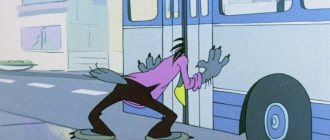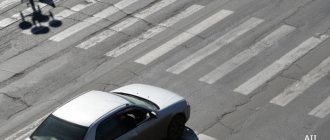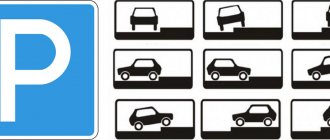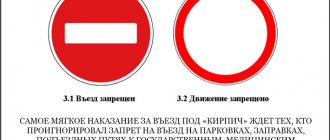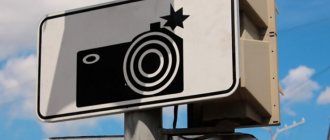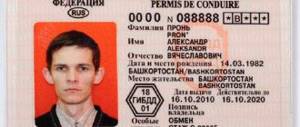To improve the comfort of travel on public transport, legislation provides benefits for buses and minibuses in some parts of the road. For example, in large cities, separate lanes are allocated for public transport, in which other drivers are prohibited from moving. In addition, at all public transport stops there are restrictions on the movement of other cars. From this article you will learn under what conditions drivers can stop and park at bus stops.
Is it possible to stop at a public transport stop?
Before examining cases when it is possible and impossible to be in a public transport stop zone, it is necessary to define the terms used:
- Stop – cessation of movement lasting less than 5 minutes, or associated with loading/unloading a vehicle, boarding/disembarking people.
- Parking/parking – stopping movement for more than 5 minutes, not suitable for other stopping conditions.
It is also necessary to establish what exactly is recognized as a public transport stop. This zone can be marked with a yellow broken line marking (in traffic regulations it is numbered 1.17) or simply with sign 5.16 - a black silhouette of a bus or tram in a white square on a blue background.
Is stopping allowed?
The entire list of circumstances that may prohibit stopping is in paragraph 12.4 of the traffic rules. Among them there are also stopping places for route vehicles. The rules say that drivers are prohibited from stopping not only directly at the public transport stop, but also within a radius of 15 m from them in both directions. The boundaries of the stop must be considered the boundaries of marking 1.17 or the location of the sign 5.16 - another 15 meters must be measured from them.
But the same paragraph of the traffic rules also provides an exception to this regulation: any driver can stop at a bus stop under 2 conditions:
- he needs to pick up or drop off a passenger;
- a stopped car does not interfere with route vehicles.
Is parking allowed?
There is no clause in the traffic rules that would specifically indicate that parking is prohibited at public transport stops. But in paragraph 12.5 of the traffic rules there is a remark that parking is prohibited in any places where stopping is prohibited. Consequently, parking at a bus stop is prohibited, since the conditions when stopping at them are permitted are an exception to the rule, and not the rule itself.
In what cases can they not be fined?
A fine for parking in a place where public transport stops is not imposed if the driver was forced to park due to breakdowns:
- in steering and braking systems;
- dimensions and headlights;
- glass cleaning systems in inclement weather.
A car cannot stop if there is a 3.27 sign nearby, especially if, when approaching, you need to cross a solid line.
When stopping due to a breakdown of his car, the driver is obliged to install an emergency sign. He also must prove to the traffic police inspectors that the car is faulty.
What is the fine?
The Code of Administrative Violations, Article 12.19 determines the amount of the fine for a car stopped at a traffic stop.
The amounts of sanctions according to the laws are as follows:
- 1000 rubles will be collected from the car owner if, when parking, he was closer than 15 meters from the sign marking the parking lot of the route transport; he will be punished for not following the rules;
- the driver will pay 2,000 rubles - a fine for stopping at a public transport stop, while creating an obstacle to route transport. In the absence of the car owner, the car may be taken to an impound lot;
- Regardless of the situation - whether there was an obstacle or not, a car owner who violated parking rules in megacities - cities of federal significance will pay 3,000 rubles.
Is it possible to avoid paying a fine or appeal it?
The driver can avoid sanctions if he can prove that he parked due to a vehicle breakdown .
A valid reason is also the poor health of him or the passenger, but this must be confirmed by a medical certificate.
It is better to slow down and stand up than to create an emergency situation. In emergency situations, you do not have to choose a parking space.
The car owner has the right to disagree with the fine issued by the traffic police. An appeal of the sanction through the court is possible within ten days from the date of issuance of this document.
The procedure is carried out on the basis of Article 30.2 of the Code of Administrative Offenses of the Russian Federation. As evidence of innocence, the driver can invite eyewitnesses and present photographs of the place where the car stopped from several angles. Prohibition signs must be visible on them.
What if the stop is forced?
Traffic regulations provide for situations where a driver may be forced to stop against his will and the rules themselves. For example, if a car malfunction occurs that prevents safe movement on the road, if the health of the driver or passenger seriously deteriorates, if necessary, to avoid an emergency. Any of these reasons makes the stop forced, which means that it should not be punished, even if it was made in violation of traffic rules.
However, in practice, not everything is so simple: in order for a stop to be legally recognized as forced, other conditions must be met: hazard lights are turned on, an emergency stop sign is displayed. In this case, the driver will not be punished, even if his car interferes with the passage of other vehicles. If the driver decides to turn on only the emergency lights, without placing the required sign behind the car, then the stop will not be recognized as forced, which means they will issue a fine, which will be quite difficult to challenge.
“No parking” sign and vehicle evacuation
If the car was left at a public transport stop, it may be taken to the impound area. A traffic police inspector may call a tow truck in the following cases:
- The vehicle is parked in such a way that it interferes with the movement of public transport;
- The driver of the car is missing.
The evacuation procedure is unpleasant in itself, because in this case the motorist loses his vehicle. However, its main disadvantage is the need for the driver to incur the following material costs:
- payment of the penalty;
- payment for tow truck services;
- payment of funds for storing the vehicle at the impound area.
According to the law, it is prohibited to evacuate a vehicle if there are people in its cabin.
Therefore, if the motorist manages to return before the car is loaded onto a tow truck, he can avoid a number of additional costs. However, he will still be fined. In the absence of the driver, the traffic police inspector must draw up a report on the detention of the vehicle. This document is drawn up in triplicate and handed over to the tow truck driver and the owner of the car. The traffic police officer keeps one copy.
The protocol is drawn up in the presence of two witnesses. They must put their signatures on the document, thereby confirming that the procedure took place without violations. The inspector must also videotape the process of loading the vehicle onto a tow truck.
What is the fine for stopping or parking near a bus stop?
Responsibility for stopping with traffic violations is enshrined in Art. 12.19 Code of Administrative Offences.
In the described case, it is necessary to consider 3 of its points:
- clause 3.1 – stopping closer than 15m from a bus stop is punishable by a fine of 1000 rubles.
- clause 4 – stopping on the road that interferes with other road users will result in a fine of 2,000 rubles.
- clause 6 - the same violations committed in Moscow or St. Petersburg are punished a little more severely - a fine of 3,000 rubles.
In addition to a fine, drivers who leave their cars at a bus stop will face an even bigger problem - having their car towed. At the same time, if a tow truck with a loaded car has already started moving, then the violator can only resign himself and subsequently pay the fine, the services of the tow truck, and the maintenance of the car in the impound lot.
Parking to the bus stop sign
You can stop at a public transport stop sign or a traffic stop.
The question is - where? There is usually a “two-way” distance ban.
That is, there should be 15 meters left before the sign, where you cannot park or stop. This is done so that other drivers can see the sign in a timely manner and react to it correctly.
You can stop within 15 meters of the sign only for the same reasons as in the stop area. In all other situations, a violation will result in a fine.
It is necessary to distinguish between the concepts of “stop” and “parking”. The first concept implies a short duration of action, its duration does not exceed five minutes. Parking is a longer event, exceeding 5 minutes.
What to do if a fine is issued?
A fine for stopping at a bus stop can be issued by both an inspector and an automatic camera for recording violations. If an employee of the State Traffic Inspectorate does this personally, and the driver is confident that he is right (for example, when the car is 15 meters from the stop or when the driver slowed down to pick up a passenger), then the motorist can try to convince the inspector that there is no violation on the spot. This will be the simplest solution to the problem, since appealing a fine to the traffic police or court is much more difficult.
If the driver agrees with the punishment, he must pay the fine within 60 days, 20 of which a 50% discount will apply. After 60 days, the amount of the fine may double in accordance with Article 20.25 of the Code of Administrative Offences.
How is punishment implemented?
The basis for the penalty is the identified violation. It must be recorded by the traffic police inspector. It is practiced today in the Russian Federation to record offenses by automatic means. Violations can be confirmed by camera images. Based on this evidence, a protocol is also drawn up.
If a discrepancy is discovered by the inspector, a report is drawn up on the spot. 3 copies are provided if a tow truck is ordered to pick up vehicles from a prohibited area. If the driver is present, 2 forms with the signatures of the offender are enough. Due to the absence of the owner of the vehicle, the papers can be drawn up in the presence of witnesses. Their presence is not necessary if there is a video or photo proving guilt.
A decision is made based on the protocol. It is sent to the offender by mail. From the moment the relevant paper is issued, 60 days are given to pay the survey amount.
If the deadlines are missed, then administrative liability will arise in the form of a fine, arrest for 15 days or forced labor.
Important!
Having caused difficulties in the movement of public transport, you can receive a punishment even if the car is parked in place for a short time.
When is it permissible to leave a car in a public transport parking lot?
Traffic rules provide for only one case when a motorist is allowed to stop the car at a public transport stop. We are talking about boarding and disembarking passengers. It is important to consider two rules:
- the motorist must not create obstacles for the passage of other vehicles;
- As soon as the passengers get out (or get into the cabin), the car must drive away from the stop.
Other cases of parking at public transport stops are illegal. If such a violation is noticed by a traffic police inspector, he is obliged to bring the driver to administrative responsibility. Also, a decision can be issued on the basis of materials recorded by traffic cameras.
The law also provides for the possibility of forced parking. For example, if the car breaks down or the driver (his passengers) feel ill. In such situations, no fine will be issued.
Parking at a public transport stop is only possible if there is some damage. These include:
- malfunction of lighting fixtures;
- incorrect operation of the steering system;
- problems with brakes;
- breakdown of windshield wipers (in bad weather).
Having received a decision from the traffic police inspector, the driver can challenge it. For example, a fine is considered unlawful if the sign prohibiting parking was out of the driver’s line of sight.

